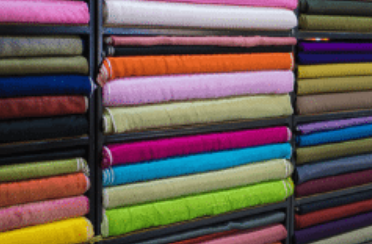5 Ways To Source Fabric
There are primarily 5 ways to source fabric. The most common are through textiles mills, fabric converters, jobbers, fabric reps, and fabric retailers. Below we cover what each of these sources do and why they may, or may not, be a viable option for designers.
1. Textile Mills
A mill is where the yarn is spun and made into fabric. Usually a textile mill will specialize in making something (i.e. cotton for quilters), which they sell in bolts to fabric retailers.
Most times an individual cannot buy from a textile mill. Mills sell to fabric suppliers and brands. The only time a textile mill will sell directly to a brand is if there is a relationship or a promise for a continued partnership.
That said: One exception is if the brand is able to purchase high minimum and promises a lasting relationship
2. Fabric Converter
Fabric converters are the ones who finish a fabric with: embroidery, dye, print, bead, pleat, and more. Typically they specialize in one type of finishing; however, multiple types of conversions in one facility is common.
The fabrics they are finishing are referred to as greige fabrics; these come off the loom and have minimal processing. Depending on the desired outcome the fabrics have to be prepared for printing or dying.
Preparations may include: bleaching, desizing, or singering.
3. Jobber
Jobbers sell leftover goods produced by the mills, odd lots; leftover fabric from clothing manufacturers, and seconds; fabric with defects.
When working with a jobber keep in mind that:
Typically low minimums
They don’t carry stock of the fabric you buy
Do not have the ability to color match
For custom or limited styles this is a great option.
4. Fabric Rep
Fabric reps want to sell you fabric and they are the most knowledgeable people to go to when looking for a fabric for your product.
With a vast directory of fabric companies fabric reps will represent a handful of companies they have built a reputation with over the years.
Finding companies with low minimums is recommended for small businesses and if you’re just starting.
Working with a fabric rep is a great option if you’re designing different types of garments and products that require various textiles.
5. Retail Fabric
Normally it’s recommended to avoid shopping for larger quantities of fabric at retail fabric stores. Just like all retail stores they have to make a profit and it’s in your best interest as a business owner to cut costs when feasible.
Retail stores also carry more exclusive fabrics that you can’t order in high quantities or re-order.
For home sewers and students: This is sometimes your only option; however, you can also find fabric from deadstock sellers, or a local garment factory will most likely give you fabric scraps.





